2010 年安徽普通高中会考英语真题及答案
本试卷分为第 I 卷和第Ⅱ卷,共四部分,八大题。第 1 卷 5 页,为选择题;第Ⅱ卷 1
页,为单词拼写和书面表达题。全卷满分 100 分,考试时间为 90 分钟。
注意事项:
第 I 卷
1. 答题前,请将自己的姓名、座位号用钢笔或圆珠笔填写在答题卡上,并用 2B 铅笔
在答题卡规定位置上将自己的座位号、考试科目涂黑。考试结束时,请将试卷和答题卡一
并交回。
2. 请将所有选择题的答案涂在答题卡上。每一小题只能从所给选项中挑选一个选项,
并用 2B 铅笔在答题卡上把该题对应的答案标号涂黑。如需改动,要用橡皮擦干净后,再涂
另一个答案。选对得分;不选、错选或多选均不得分。
I.关键词语选择(共 5 小题;每小题 1 分,满分 5 分)
第一部分听力(共三大题,满分 20 分)
听下面五个句子。从每小题所给的 A、B、C 三个选项中选出你所听到的单词或短语。每
个句子读两遍。
1.
2.
3.
4.
5.
A. pop
A. topic
A. apply
A. lovely
A. go out
B. folk
B. hobby
B. appear
B. likely
B. give up
C. country
C. habit
C. admire
C. lively
C. get ready
Ⅱ. 短对话理解(共 5 小题:每小题 1 分,满分 5 分)
听下面五段对话。每段对话后有一个小题,从每小题所给的 A、B、C 三个选项中选出
一个最佳选项。每段对话读两遍。
6.
What present will Jack probably get?
A. A bicycle.
B. A basketball.
What did the boy think of the game?
A. Boring
What are the two speakers talking about?
A. Birthplace.
B. English study.
What season is it now?
A. Spring
B. Exciting
B. Summer.
7.
8.
9.
C. Sports shoes.
C. Interesting
C. Foreign friends.
C. Autumn
10. What is the woman going to do first?
A. To go home
B. To stay for tea.
C. To buy some fruits.
III. 长对话和独白理解(共 10 小题;每小题 1 分,满分 10 分)
听下面三段对话或独白。每段对话或独白后有个小题,从每小题所给的 A、B、C 三个
选项中选出一个最佳选项。每段对话或独白读两遍。
听下面一段对话,回答第 11 至第 13 小题。
11. What did the woman fail to put in the form?
A. Name.
B. Nationality.
C. Address.
12. Who did the woman come to visit?
A. Her mother
B. Her teacher.
C. Her daughter.
13. What's the possible relationship between the two speakers?
B. Passenger and officer.
A. Teacher and student
and wife.
C. Husband
�
听下面一段对话,回答第 14 至第 16 小题。
14. Where is the nearest bookstore?
A. Next to bus station
of a red building.
B. At the end of the street.
C. In front
15. What did the man advise the woman to do?
A. To go on foot.
B. To take a bus.
C. To take a taxi.
16. Where did the conversation probably take place?
A. At home.
B. In the library.
C. On the street.
听下面一段独白,回答第 17 至第 20 小题。
17. When did Steve start painting?
A. At the age of three.
of five.
B. At the age of four.
C. At the age
18. Why did many people buy his pictures?
A. Because they loved the boy.
wanted to make money.
B. Because the boy was famous. C. Because they
19. Where did the boy paint on the paper?
A. On all of the paper.
bottom half of the paper.
B. On the top half of the paper.
C. On the
20. How would the person probably feel after hearing the boy's reply?
A. Angry.
B. Surprised.
C. Happy.
第二部分 英语知识运用(共两大题,满分 20 分)
IV. 单项填空(共 10 小题;每小题 1 分,满分 10 分)
从 A、B、C、D 四个选项中,选出一个可以填入空白处的最佳选项。
21. What ______ pity you didn’t go to _______ concert with us! It was so exciting!
D. the;
C. a; 不填
B. a; the
A. 不填; a
the
22. A group ticket admits six people _______ the zoo or the museum
A. for
B. to
C. at
D. in
23. – Could you help me with some math problems? – Sure. That's _______ I'm here.
A. whether
B. how
C. when
D. why
24. I’ve just read your blood test report and all seems OK, so there’s _______
to worry about.
A. something
everything
B. anything
C. nothing
D.
25. Do you know the boy under the tree_______ is playing with a dog?
A. which
B. as
C. who
D. what
26. – Can I have your name, sir? – Er… Albert Johnson, if you_______ know.
A. must
B. can
C. may
D. need
27. – How did you like your trip to the mountain village last Sunday?
– It couldn't be worse. My bicycle _______ several times on the way.
A. got down
down
C. slowed down
B. broke down
D. settled
28. – Why did you start out so early yesterday morning? – _______ there on time.
�
A. To get
B. Getting
C. Get
D. Got
29. Hi, Jack. Nice to see you here. I _______ you would come to the party.
A. don't know
known
B. didn't know
C. haven't known
D. hadn't
30. – Rose, I’ve just written a poem. Want to read it? – _______? Come on
A. What for
B. How come
C. Why not
D. So what
V. 完形填空(共 10 小题;每小题 1 分,满分 10 分)
阅读下面短文,从短文后每小题所给的 A、B、C、D 四个选项中,选出一个可以填入空
白处的最佳选项。
Children like to copy what they hear. They copy 'their parents, their friends
to speak the language. They don't practice
use the language to talk about things that interest them. They don't
themselves,
and even the TV. This teaches them
grammar,
worry about their
and they do it successfully.
or poor grammar. They can find ways to
31
34
32
33
Copying is also good for students to learn a foreign language. When you listen
what they say as possible as you can. You
with
to talk to, talk with other
. You can also join an English club or go to an English
to foreigners speaking English,
should also pay your attention to communication. Look for chances to
native speakers of English. If you can't find a
students in English
corner to talk about music, movies or
interests you.
_ 39
36
37
38
35
40
C. when
C. but
B. where
B. or
Don't worry about making
. The aim is to learn how to communicate easily
and comfortably. Remember that you can communicate successfully even with a small
vocabulary.
31. A. how
32. A. so
33. A. course
34. A. express
35. A. prepare
36. A. walk
37. A. foreigner
38. A. too
39. A. whichever
40. A. tricks
D. composition
D. remind
D. repeat
D. since
D. whenever
D. mistakes
B. understand
B. master
C. though
C. whatever
C. passage
C. teach
B. vocabulary
C. classmate
B. wherever
B. teacher
B. noises
C. notes
D. why
D. nor
C. hold
C. talk
D. help
D. parent
B. camp
B. instead
VI. 阅读理解(共 20 小题;每小题 2 分,满分 40 分)
第三部分 阅读理解(共一大题,满分 40 分)
阅读下列短文,从每小题所给的 A、B、C、D 四个选项中,选出一个最佳选项
A
Sir Arthur Conan Doyle, who wrote the story of the detective (侦探) Sherlock
Holmes, was having a trip in Europe. One day he got out of the railway station and
climbed into a taxi. Before he could say a word, the driver turned to him and asked,
“Where can I take you. Mr. Doyle?”
Doyle was rather surprised. He asked the driver if he had ever seen him before.
“No, sir,” the driver replied, “I have never seen you before.” Then he explained,
“This morning’s newspaper had a story about your being on vacation in Marseilles.
This is the taxi stop where people who return from Marseilles always come. Your
skin color tells me you have been on vacation. The ink spot on your right fingers
�
suggests to me that you are a writer. Your clothes are very English, not French.
Adding up all those pieces of information, I conclude that you are Sir Arthur Conan
Doyle.”
“This is truly surprising!” the writer cried out. “You are a real-life copy
to my fictional (虚构的) story, Sherlock Holmes!”
“And there is one other thing,” the driver added, with a smile on his face.
“What’s that?”
“Your name is on the front of your suitcase. “
41. The conversation between the two people took place _________.
A. at a bus stop
in a railway station
B. in a taxi
C. in Marseilles
D.
42. Doyle was rather surprised because _________.
A. the driver had seen him before
name
C. the driver was waiting for him
from him
B. the driver could call him by his
D. the driver answered no questions
43. After he heard the driver’s analysis, Doyle concluded that _________.
A. the driver was Sherlock Holmes
C. he had met the driver long before
to his story
B. he once wrote a story about the driver
D. the driver was a real-life copy
44. From what the driver said, we could know _________.
A Doyle was from England
C. Doyle liked English very much
B. Doyle could not speak French
D. Doyle was writing a French story
45. The driver knew the writer’s name because _________.
A. Doyle told the driver himself
C. the morning’s newspaper had said that
information
B. it was on the front of his suitcase
D. the detective let out the
B
How important can a fifteen-year-old boy’s work be? Well, Louis Braille’s
work changed the world. Born in a small town near Paris in 1809, shortly after his
third birthday Louis blinded himself in one eye while playing with a sharp pointed
tool in his father’s workshop. He soon lost the sight in his other eye when the
infection (感染) spread.
He wanted to go to school, but in his small town there was no school for him
At that time, blind people did not get any school education. Braille went to Paris
to study, but there were few books for the blind.
Louis knew that books were the key to learning. He struggled with ideas for
three years. Finally, at fifteen, he invented an alphabet made with raised dots
(点). The dots were arranged in a certain pattern for each letter. Blind people
could “read” by feeling the patterns of the dots.
Being able to read Braille allows blind children to learn together with the
sighted children at school, and go on to get jobs. It allows people who lose their
sight later on in life the chance to continue to read, learn and get information
46. Braille got blind as a result of _________.
A. An illness
fire
B. an accident
C. a party
D. a
47. From the passage we know in Braille’s day, _________.
�
A there were no schools in the town
to school
C. there were few books for the blind
by talking
B. none of the blind could go
D. blind children could read
48. It took Braille_________ to invent the alphabet.
A. three years
years
B. six years
C. fifteen years
D. many
49. The Braille alphabet _________.
A. was of no use for the blind people
money
C. allowed people to get information directly
learn more easily
50. Which could be the best title for the passage?
A. Louis Braille changed the world
his life
C. Louis Braille saved sighted children
school
B. helped Louis make much
D. made the blind read and
B. Louis Braille struggled in
D. Louis Braille set up a blind
C
Advertisements
Course A: Understanding computers
◆ A twelve-hour course for people who do not know very much about computers but
need to learn about them. You can learn what computers are, what computers can
do and cannot do, and how to use them.
◆ Course fee: $ 75, from June I to June 28, 9~12 a. m. every Sunday.
◆ Equipment fee: $ 10.
◆ Teacher: Joseph Saunders, professor of computer science at New Urban University,
with twelve years of experience in computer field.
Call 67801642 or 67801643 for more information
Course B: Learning to speak French
◆ A course with a small class of less than 20 people, twice a week. Your French
level is tested in the first class. Then you can begin practicing at one of
eight different skill levels. This allows you to learn at your own speed, and
prepares you to learn through situations of real life with a funny and easy
method.
◆ Course fee: $ 200,from June l to June 25,4~7 p. m every Monday and Thursday.
◆ Personal tutoring fee: $ 100.
◆ Teacher: From the first day on you can have your own personal French teacher
that corrects your exercises and assists you along the course, who has
successfully taught French course before.
Phone 67353019 for more information
Course C: Learning to swim
◆ A course for people who have interest in swimming. We offer morning and afternoon
classes, where swimming knowledge will be taught. Then you can gain swimming
skills through practice in water.
◆ Course fee: $ 150, from June 9 to June 29, 10 a. m. ~4 p. m. every Tuesday and
Friday.
◆ Personal tutoring fee: $ 100.
�
◆ Teacher: Teachers from sports college and experienced swimming-lovers.
Very close to the Central Park. For further information call 67432308.
51. The computer professor has got _________ years of experience in computer field.
A. seven
B. nine
C. ten
D. twelve
52. If you want to take Course A, you need to go _________to learn something about
computers.
A. twice every week
Sunday afternoon
B. three times a week C. four times altogether
D. every
53. Having a test in the first French class is to_________.
A. correct your exercises
C. practice your eight different levels
for the course
B. learn your speaking speed
D. know your French level
54. With a personal swimming trainer helping you along the course, you should pay
_________ for the course altogether.
A. $100
B. $150
C. $200
D. $250
55. If you want to know more about the French-learning course, you can phone
_________.
A. 67801642
B. 67353019
C. 67432308
D. 67801643
D
Tea drinking was in China for nearly one thousand years before anyone in Europe
had ever heard about tea. People in Britain were much slower in finding out what
tea was like, mainly because tea was very ex- pensive. It could not be bought in
shops. People had it sent from Holland. And even those people who could afford it
did so only because of curiosity. Some of them were not sure how to use it. They
thought it was a vegetable and tried cooking the leaves. Then they served them mixed
with butter and salt. They soon discovered their mistakes but many people used to
spread the used tea leaves on bread and give them to their children as sandwiches.
Tea remained very expensive in England until the ships of the East India Company
began to bring it direct from China early in the seventeenth century. During the
next few years so much tea came into the country that the price fell and many people
could afford to buy it.
At the same time people on the continent were becoming more and more fond of
tea. Until then tea had been drunk without milk in it, but one day a French lady
named Madame de Sevigne decided to see what tea tasted like en milk was added. She
found it so pleasant that she would never again drink it without milk. Because she
was so famous a lady that people liked to copy everything she did, they also drank
their tea with milk in it. Slowly habit spread until it reached England and today
only very few British people drink tea without milk.
At first, tea was usually drunk after dinner in the evening. No one ever thought
of drinking tea in the after- until a duchess (公爵夫人) found that a cup of tea
and a piece of cake at three or four o’clock stopped her getting “a sinking feeling”
as she called it. She invited her friends to have this new meal with her and so,
tea-time was born.
56. The word “curiosity” in the first paragraph probably means _________.
A. 好奇
B.臆测
C. 迷恋
D. 决心
57. Which of the following is true of tea-drinking in Britain?
A. The British people got expensive tea from India.
�
B. The habit of tea-drinking reached Britain from France.
C. The British people were much slower in getting the habit.
D. People in Britain began drinking tea one thousand years ago.
58. Some people cooked tea leaves because _________.
A. Most children liked to have them
C. they didn’t know how to use them
them
B. they were very good vegetables
D. sandwiches needed mixing with
59. People in Britain like to drink tea with milk because of the influence of
_________.
A. a famous French lady
C. the upper social class
60. This passage mainly discusses _________.
B. people in Holland
D. the ancient Chinese
A how tea-time was born in history
Britain
C. the habit of drinking tea with milk in it
tea-drinking in Europe
B. the history of tea-drinking in
D. differences about
第Ⅱ卷
注意事项:
1. 答题前,请将密封线内的项目填写清楚,并在本页右上角“座位序号”栏中填写座位号
最后两位数字。
2. 第Ⅱ卷共 1 页,请用钢笔或圆珠笔将答案直接写在试卷上,不得将答案写在密封线内。
VII. 单词拼写(共 5 小题;每小题 1 分,满分 5 分)
第四部分 写(共两大题,满分 20 分)
根据汉语释义和英文首字母完成下列单词拼写,使句意完整正确。
61. Please keep c______________(平静) whatever happens.
62. We are sure to d______________(打败) their team in the game.
63. It is believed that all men and women are e______________(平等的)
64. We’ve known about each other but never a______________(事实上)met.
65. Any change in diet will have an e______________(影响)on your health
VIII.书面表达(共 1 小题,满分 15 分)
假定你是李国华,你班将接待一名英国交换生 Robert,请你给他发一封电子邮件,简
单介绍一下你们的班主任老师。要点如下:
1. 热爱教学,关心学生;
2. 工作热情,和蔼可亲;
3. 学识渊博,风趣幽默……
注意:1.词数 100 左右;
2.邮件的开头和结尾已给出,不计入总词数;
3.可适当增加细节,以使行文连贯。
Dear Robert,
I’m very glad to know that you will come to my class to study for a year.
_________________________
______________________________________________________________________________
______________________________________________________________________________
______________________________________________________________________________
______________________________________________________________________________
�
____________________________________________________
I’m looking forward to your coming!
Yours,
Li Guohua
2010 年安徽普通高中会考英语答案
6-10 CABBC
11-15 CABBA
16-20 CACCB
26-30 ABABC
36-40 CABCD
第一部分 听力
I – III. 1-5 BCAAC
第二部分 英语知识运用
Ⅳ.单项填空
21-25 BBDCC
V.完形填空
31-35 ACBAD
第三部分 阅读理解
Ⅵ。阅读理解
41-45 BBDAB
第四部分 写
Ⅶ.单词拼写
61. Calm
Ⅷ.书面表达
One possible version:
Dear Robert,
62. Defeat
46-50 BCADA
51-55 DCDDB
56-60 ACCAB
63. Equal
64. Actually 65. Effect
I’m very glad to know that you will come to my class to study for a year. I’
d like to introduce our class teacher to you. He is enthusiastic about his teaching
and loves his students very much. He is very strict in his work and very kind to
his students. When his students turn to him for help, he is always patient enough
and ready to help them with their problems. He is well received by us students and
other teachers as a learned teacher with a sense of humor.
In a word, he is a good teacher who is wise, helpful and warm-hearted. I’m
sure you’ll get along well with him and have a good time here.
I’m looking forward to your coming!
Yours,
Li Guohua
评分标准:
本题总分为 15 分,按四个档次给分:
第四档(12-15 分):能写明全部或绝大部分要点;语言表达准确或有少量错误,行文基本
连贯,表达基本清楚。
第三档(8-11 分):能写明基本要点;语言虽有较多错误,尚能达意。
第二档 (4-7 分):能写明部分要点;语言错误多,影响意思表达。
第一档 (0-3 分):白卷或错误很多,不知所云。
�
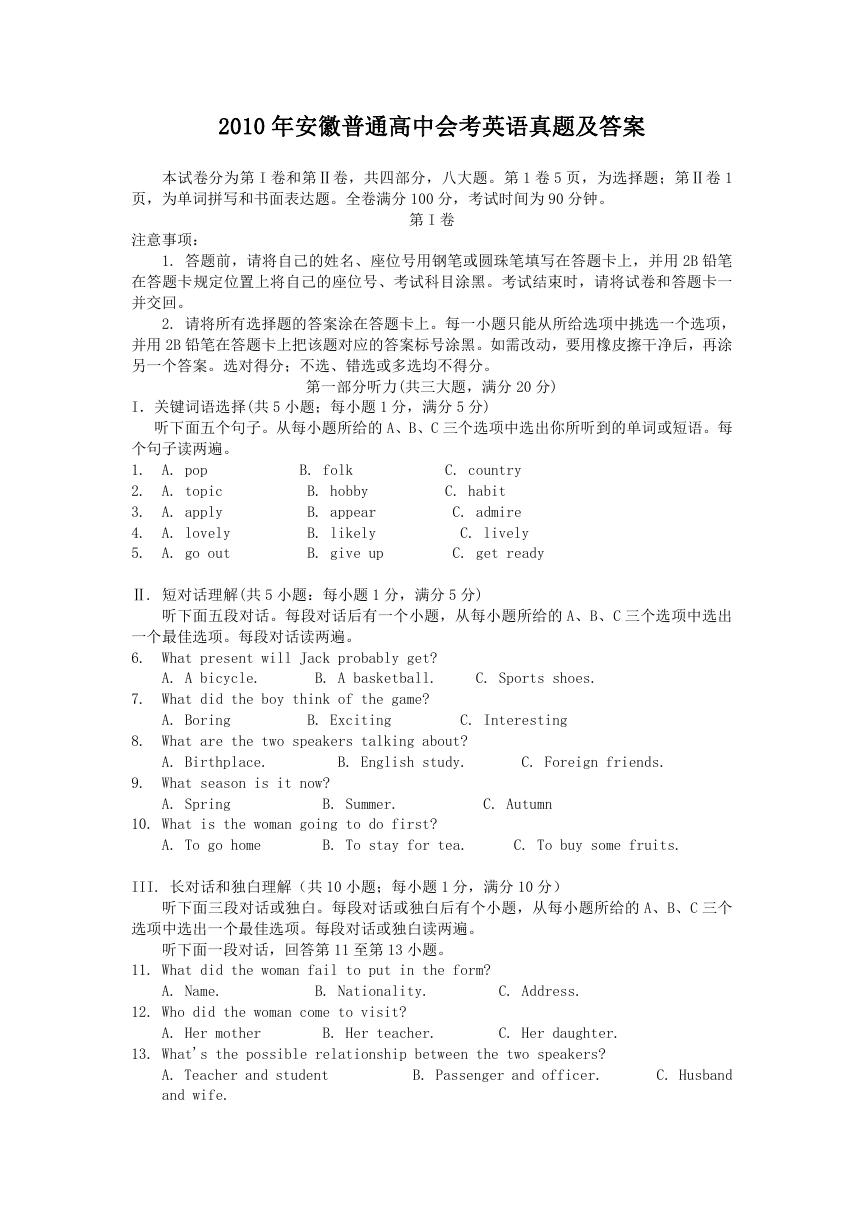
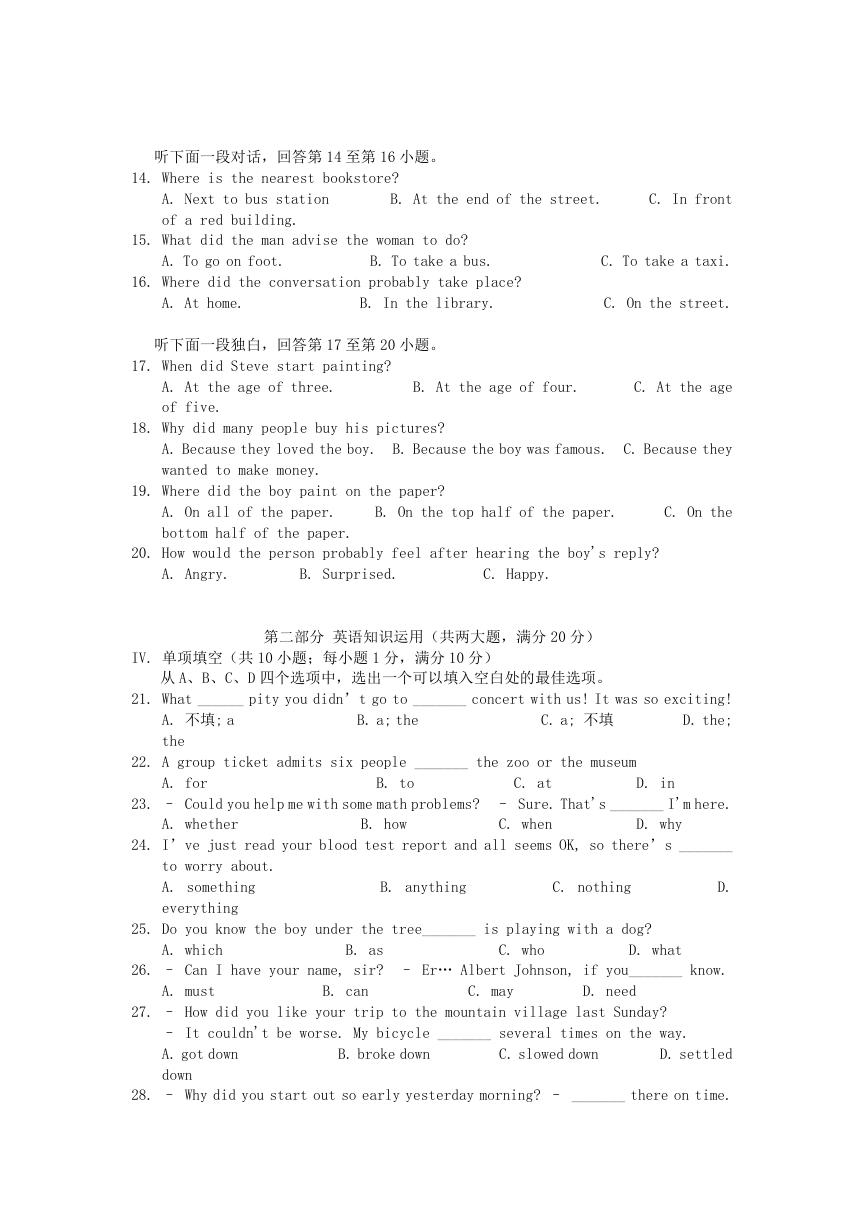
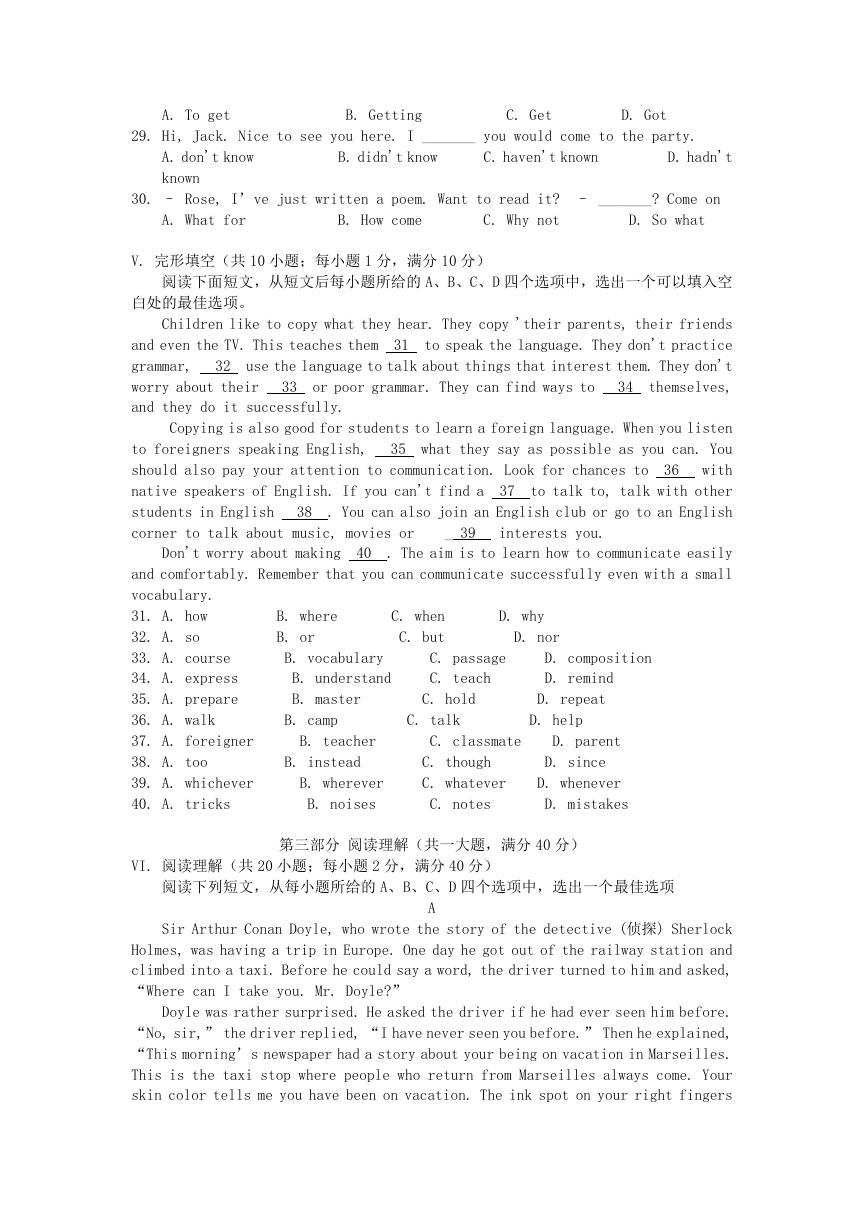



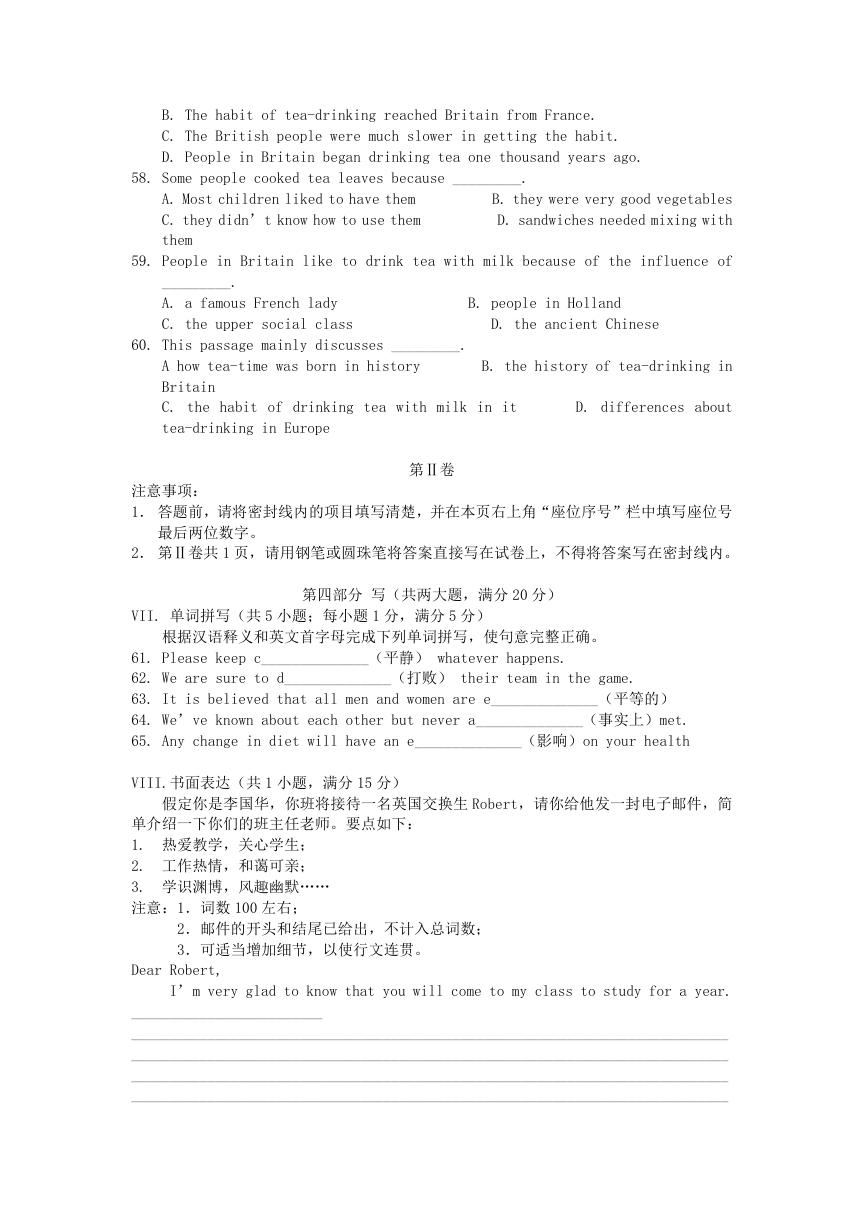
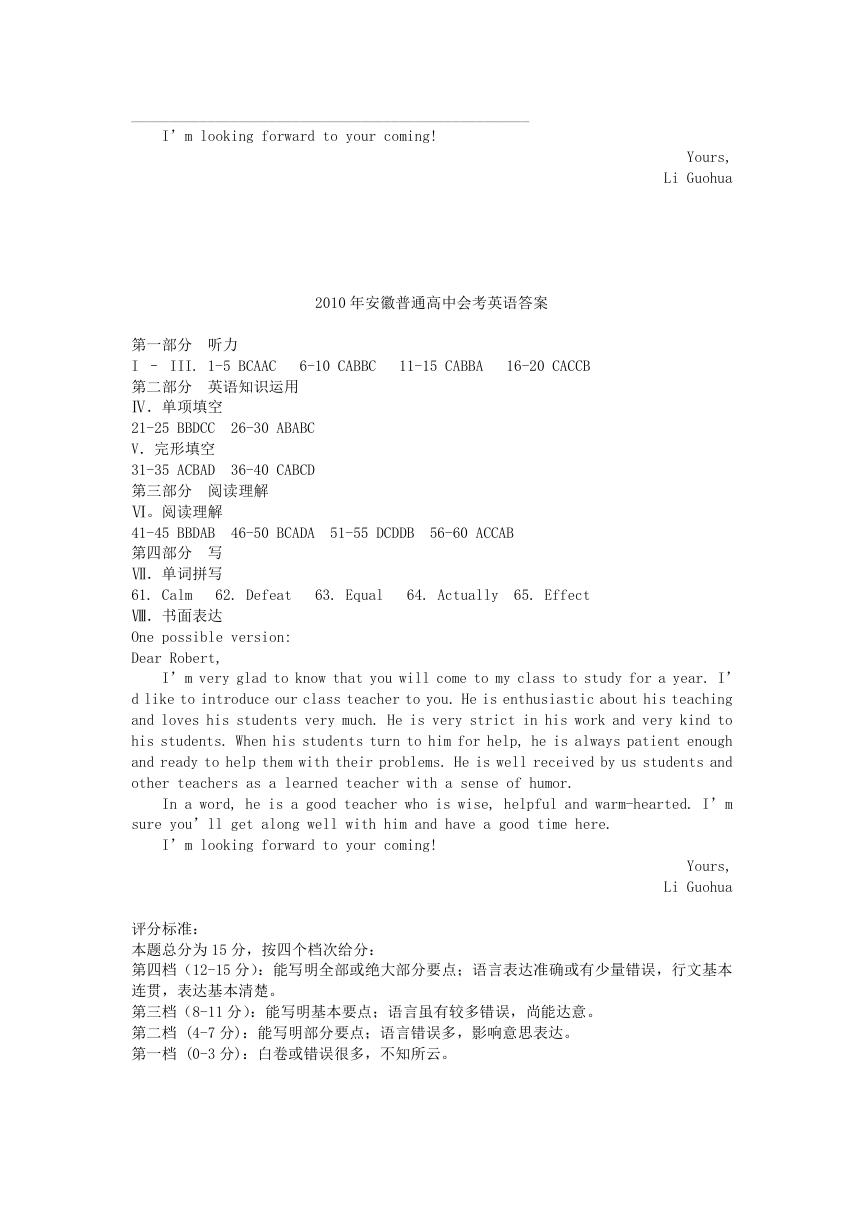








 2023年江西萍乡中考道德与法治真题及答案.doc
2023年江西萍乡中考道德与法治真题及答案.doc 2012年重庆南川中考生物真题及答案.doc
2012年重庆南川中考生物真题及答案.doc 2013年江西师范大学地理学综合及文艺理论基础考研真题.doc
2013年江西师范大学地理学综合及文艺理论基础考研真题.doc 2020年四川甘孜小升初语文真题及答案I卷.doc
2020年四川甘孜小升初语文真题及答案I卷.doc 2020年注册岩土工程师专业基础考试真题及答案.doc
2020年注册岩土工程师专业基础考试真题及答案.doc 2023-2024学年福建省厦门市九年级上学期数学月考试题及答案.doc
2023-2024学年福建省厦门市九年级上学期数学月考试题及答案.doc 2021-2022学年辽宁省沈阳市大东区九年级上学期语文期末试题及答案.doc
2021-2022学年辽宁省沈阳市大东区九年级上学期语文期末试题及答案.doc 2022-2023学年北京东城区初三第一学期物理期末试卷及答案.doc
2022-2023学年北京东城区初三第一学期物理期末试卷及答案.doc 2018上半年江西教师资格初中地理学科知识与教学能力真题及答案.doc
2018上半年江西教师资格初中地理学科知识与教学能力真题及答案.doc 2012年河北国家公务员申论考试真题及答案-省级.doc
2012年河北国家公务员申论考试真题及答案-省级.doc 2020-2021学年江苏省扬州市江都区邵樊片九年级上学期数学第一次质量检测试题及答案.doc
2020-2021学年江苏省扬州市江都区邵樊片九年级上学期数学第一次质量检测试题及答案.doc 2022下半年黑龙江教师资格证中学综合素质真题及答案.doc
2022下半年黑龙江教师资格证中学综合素质真题及答案.doc